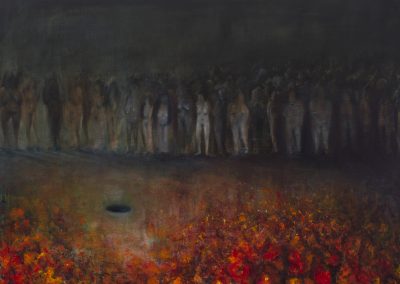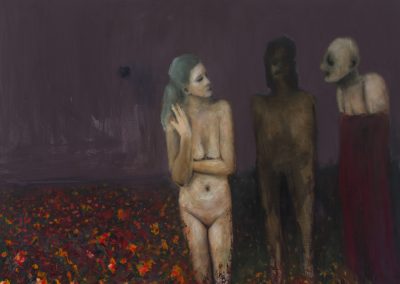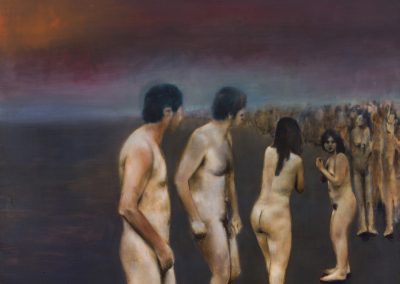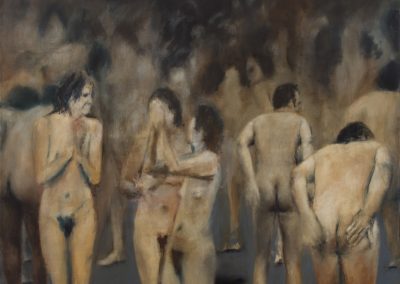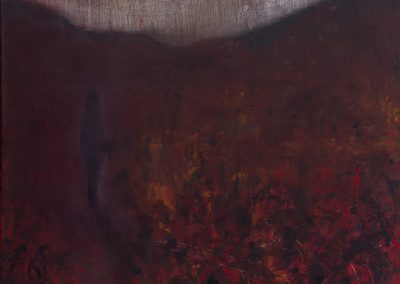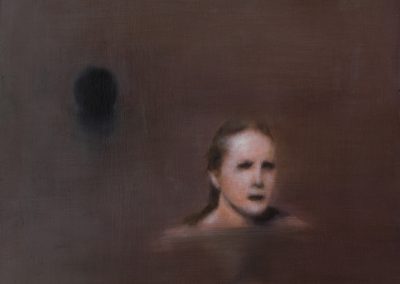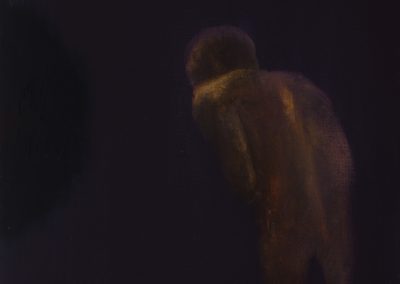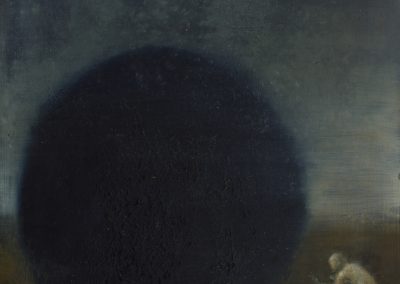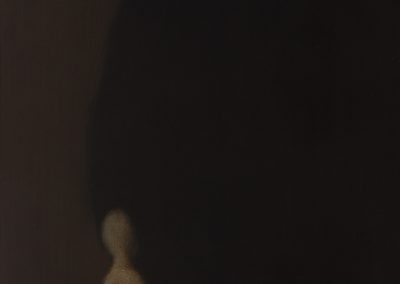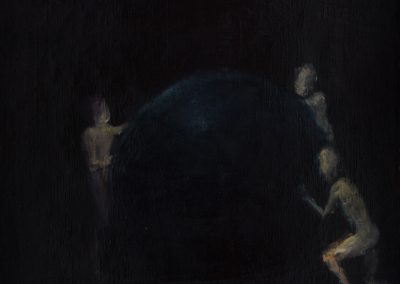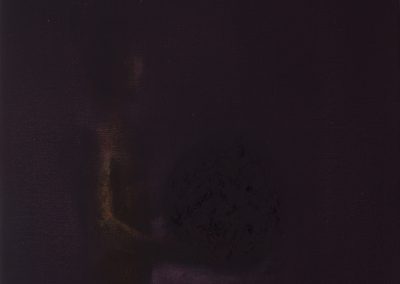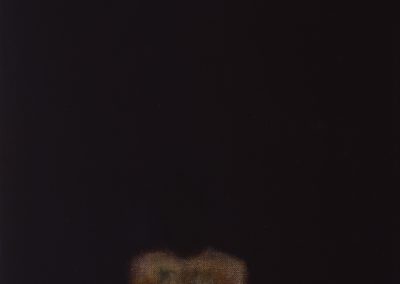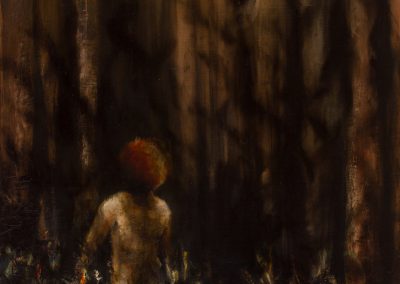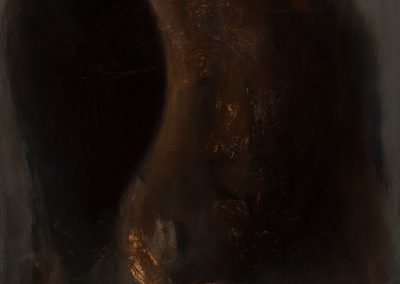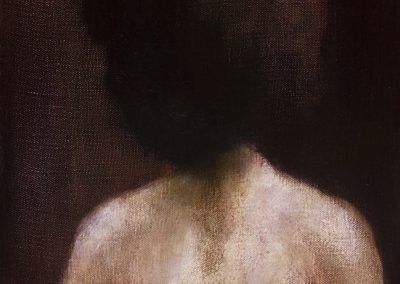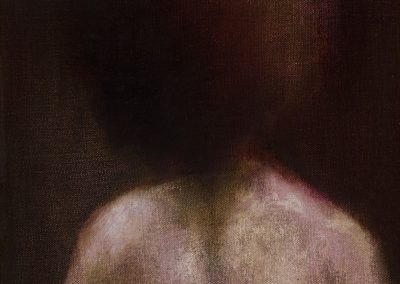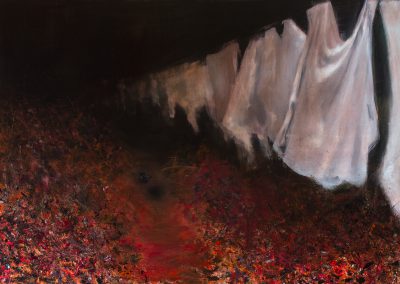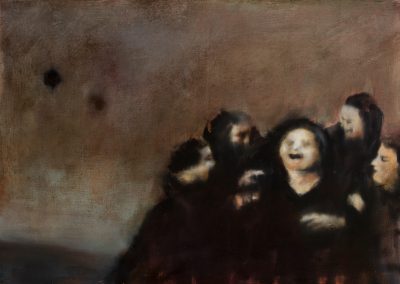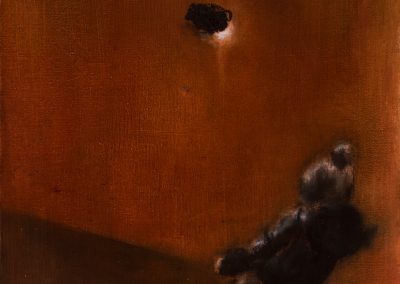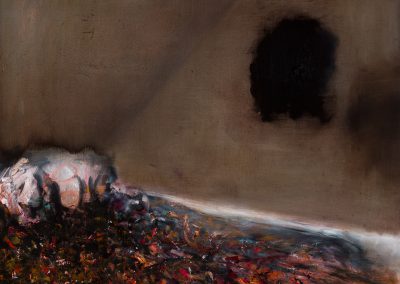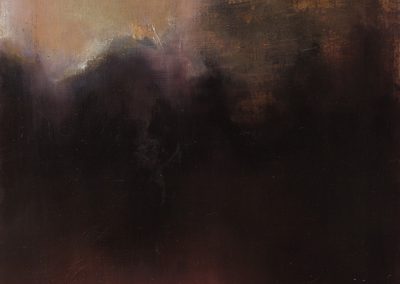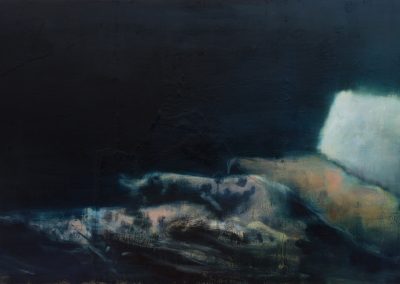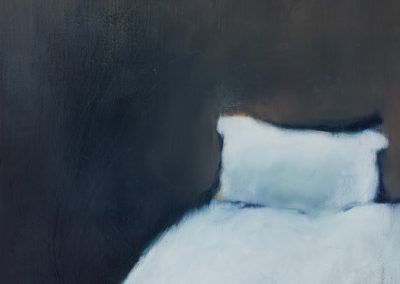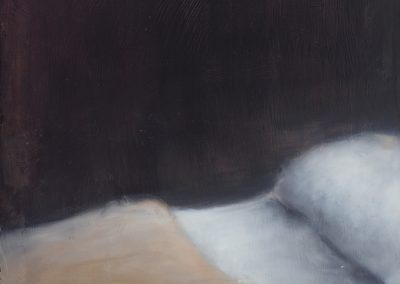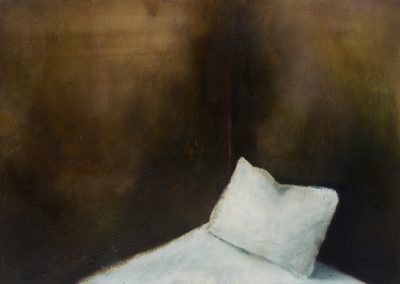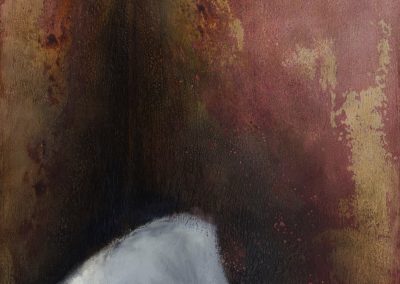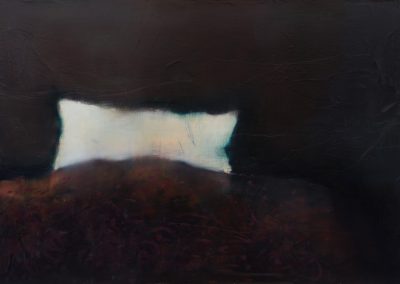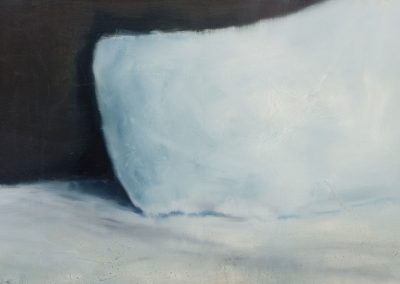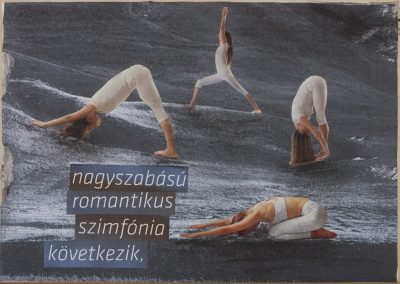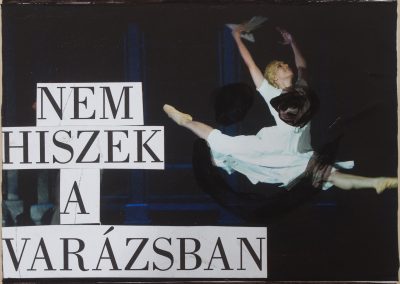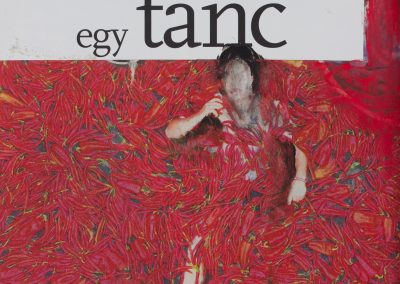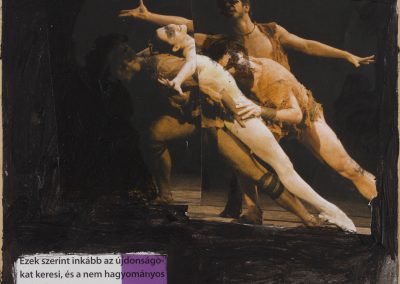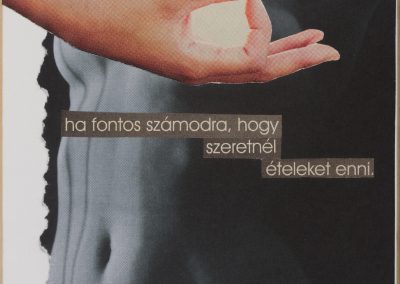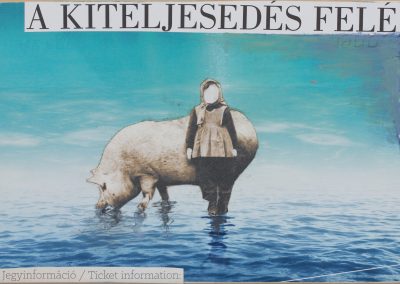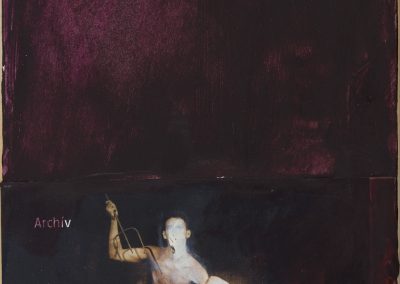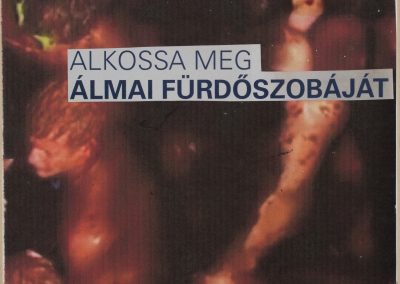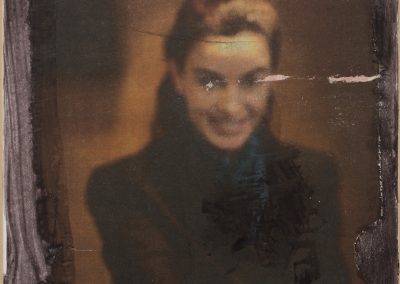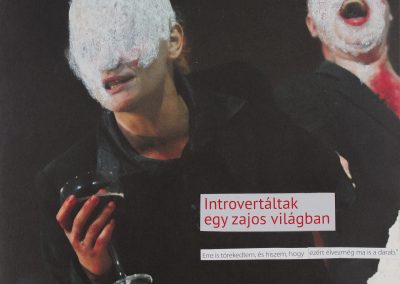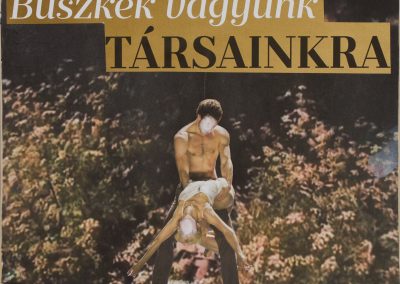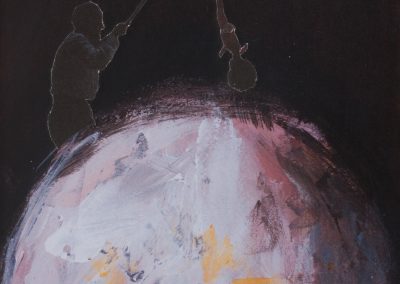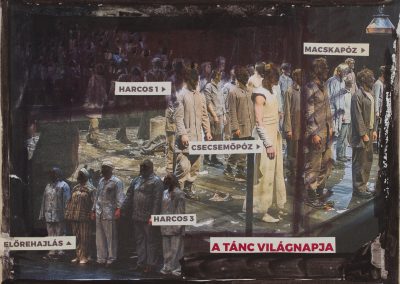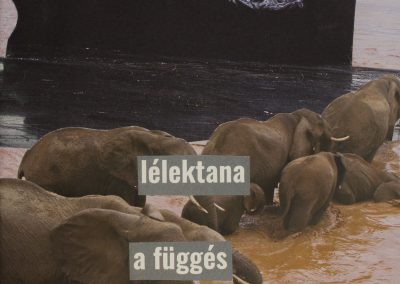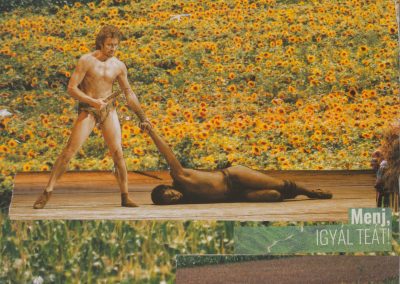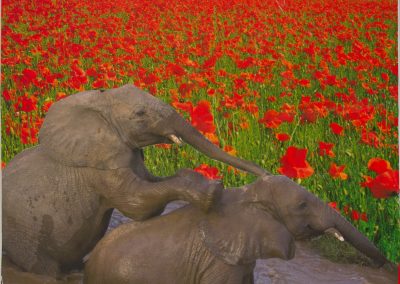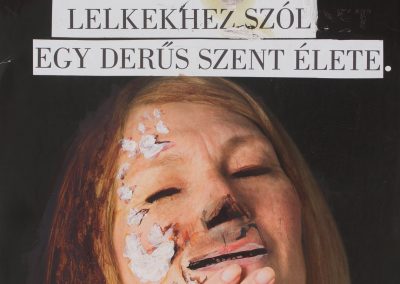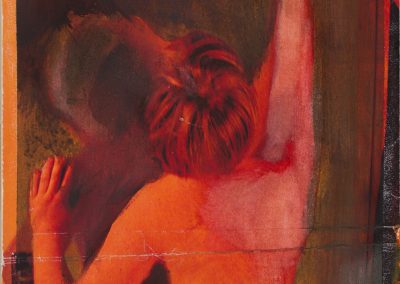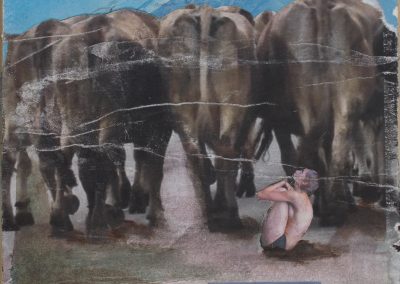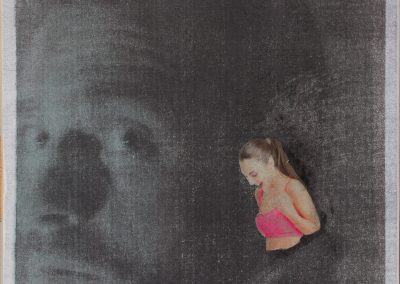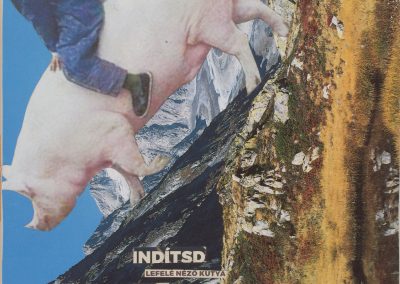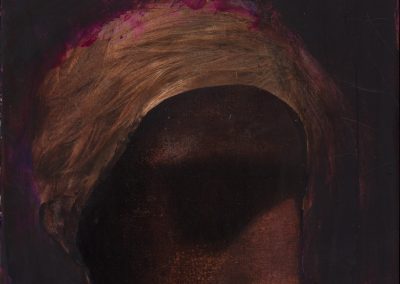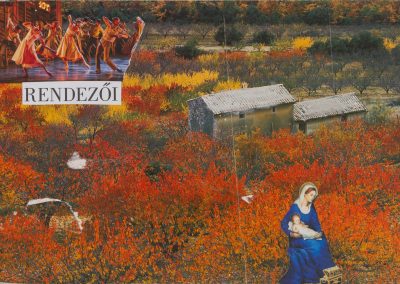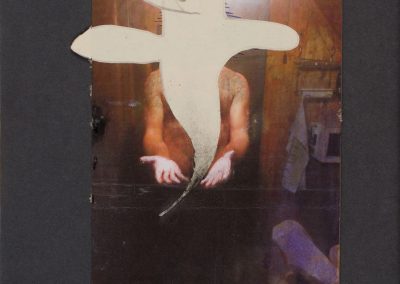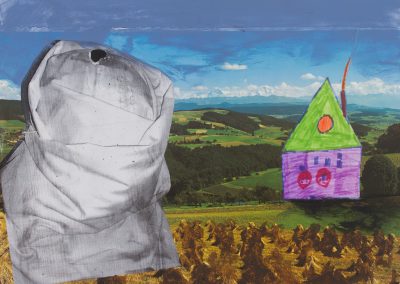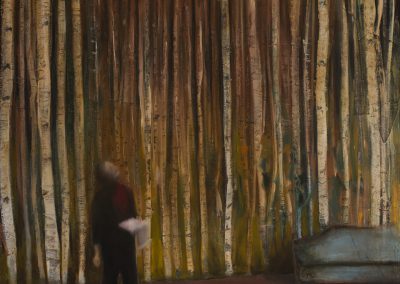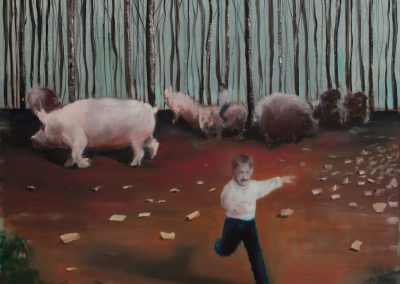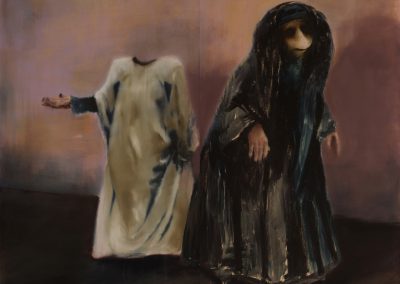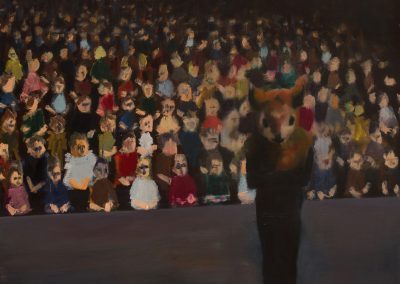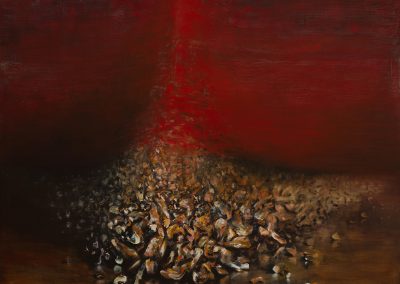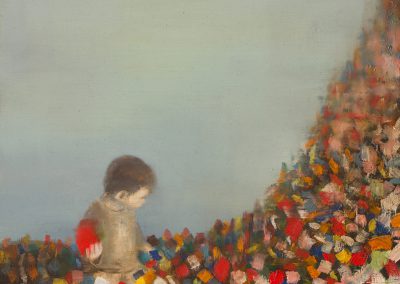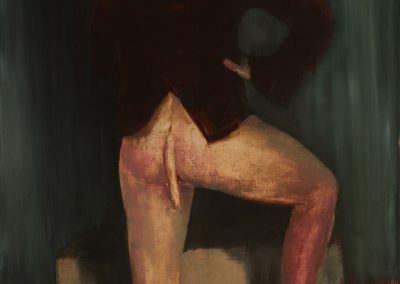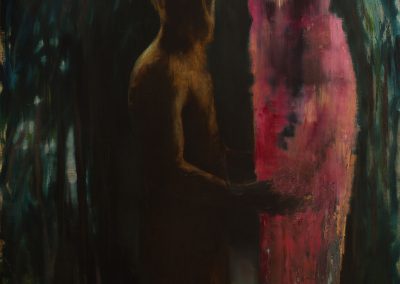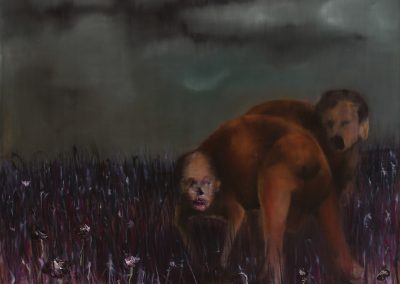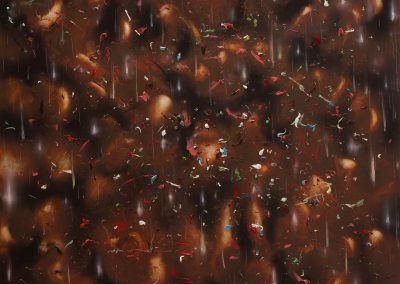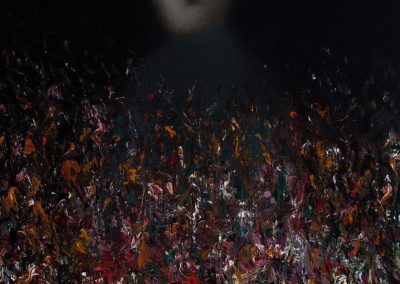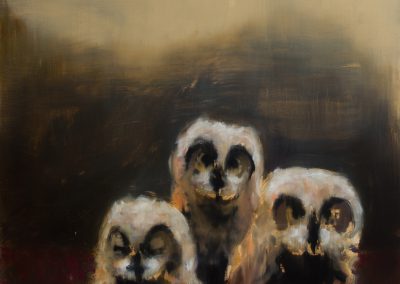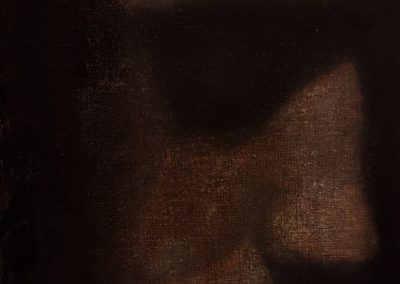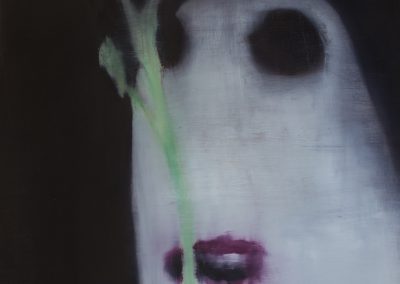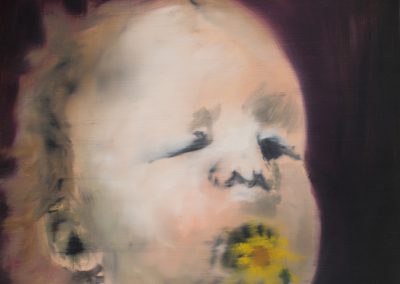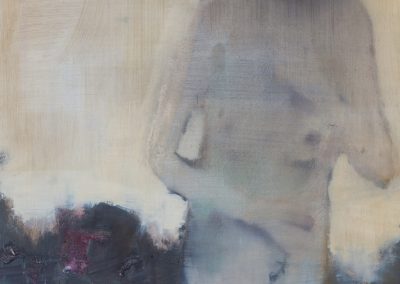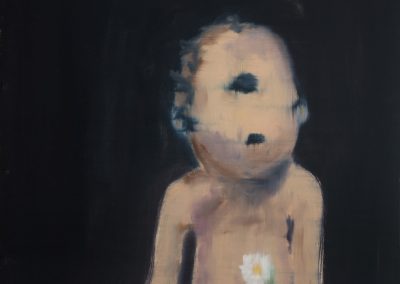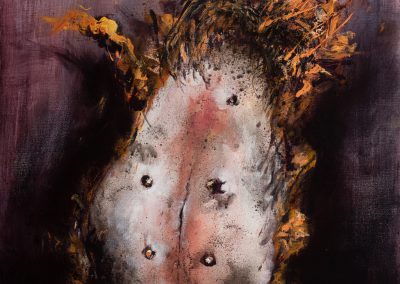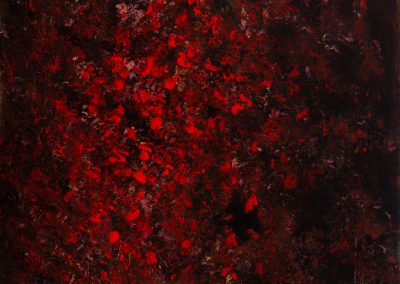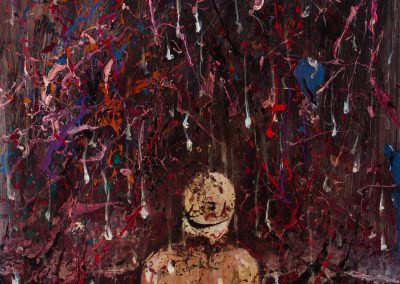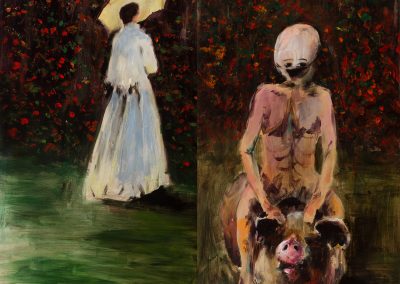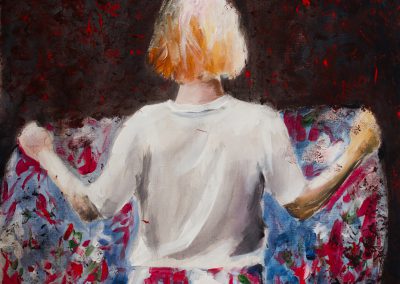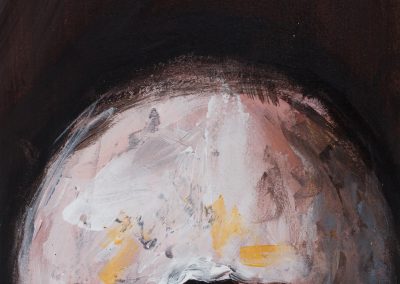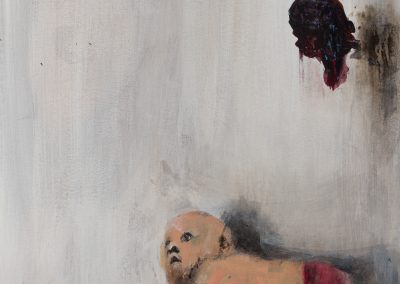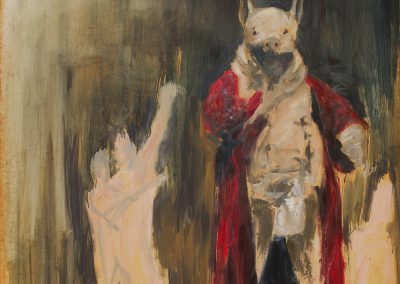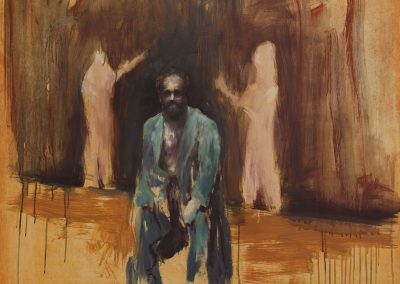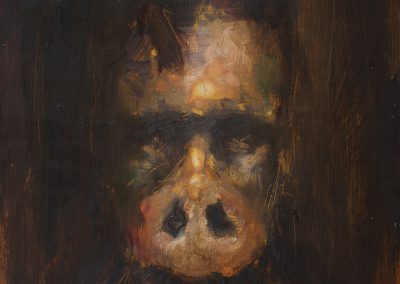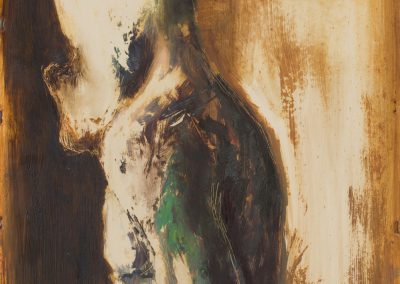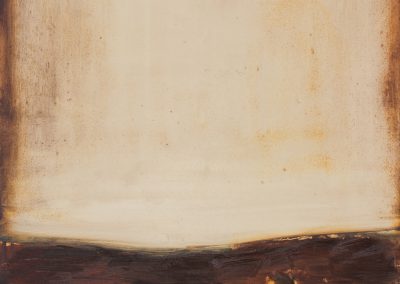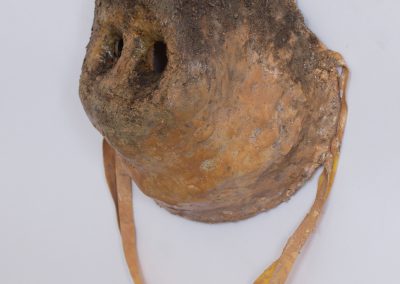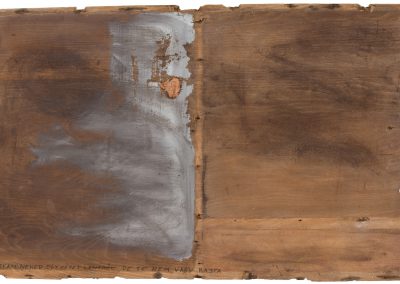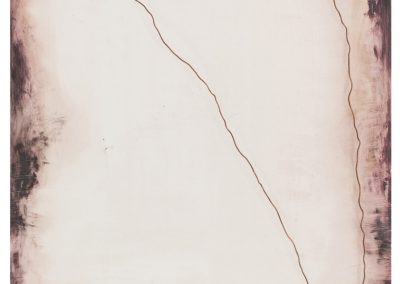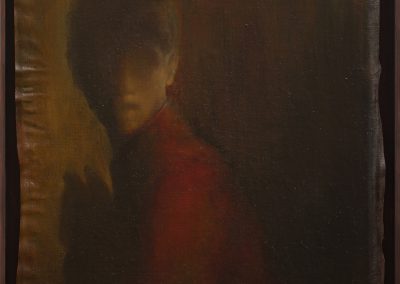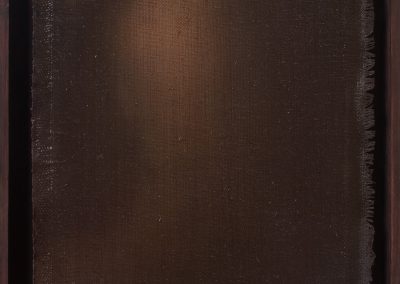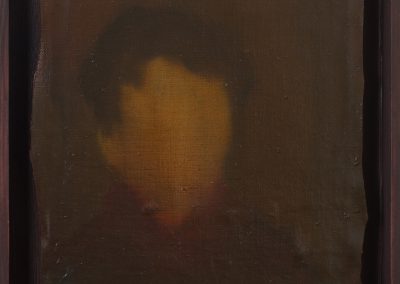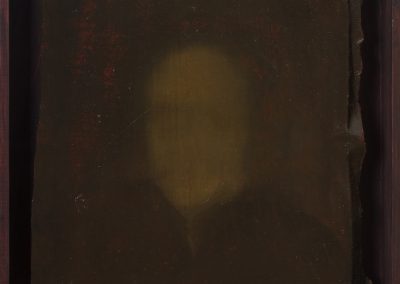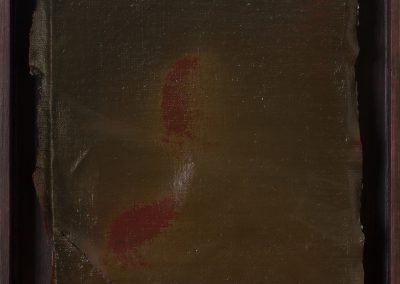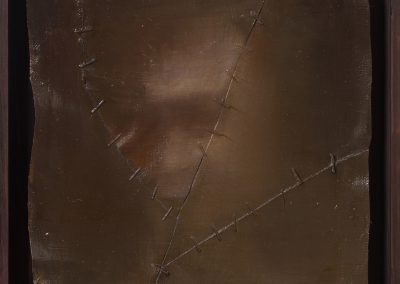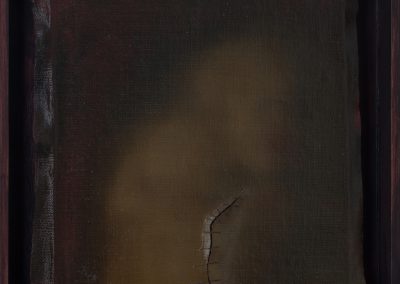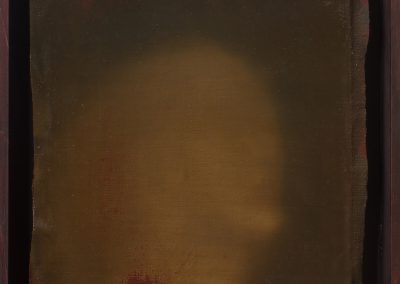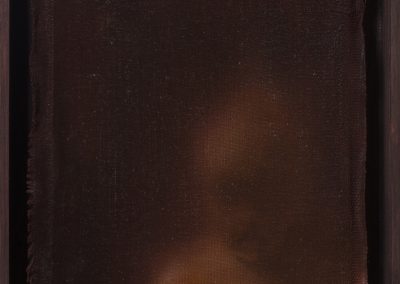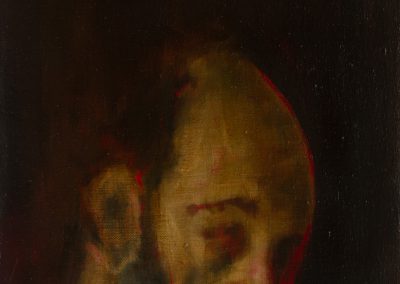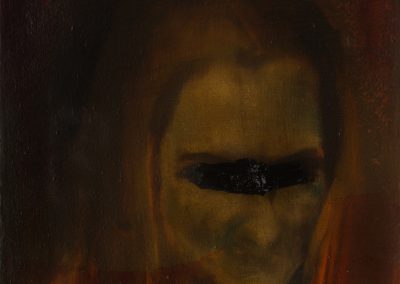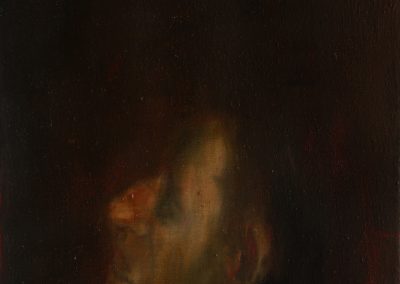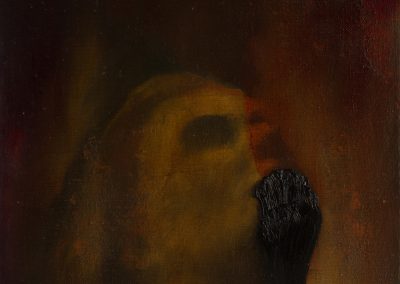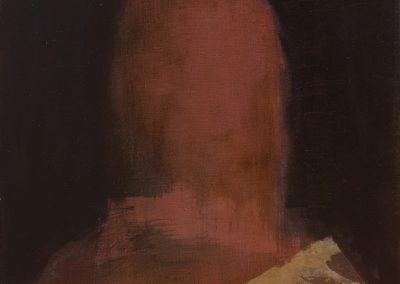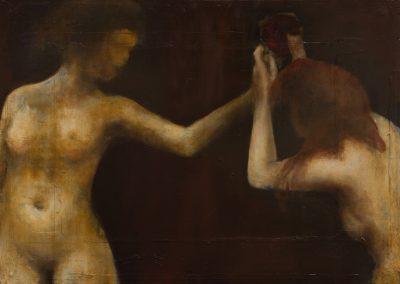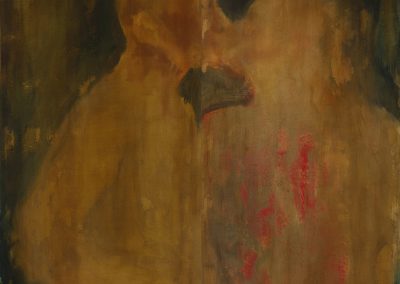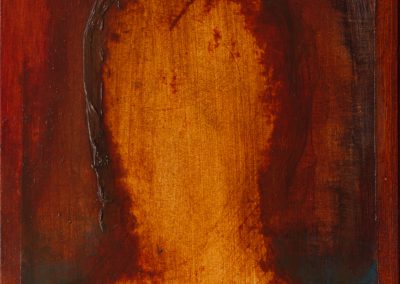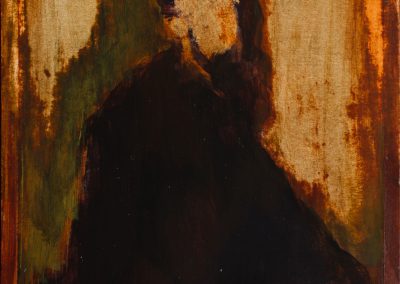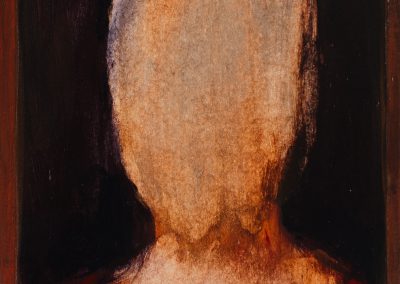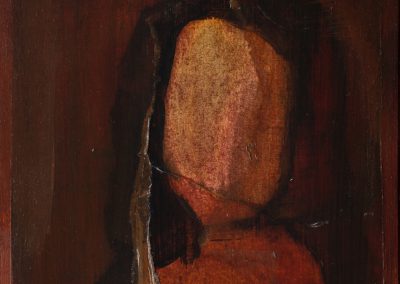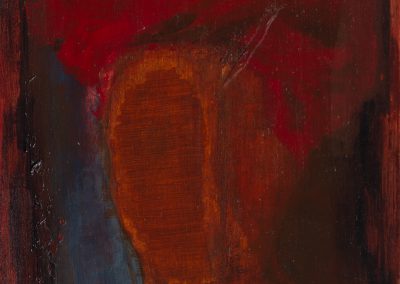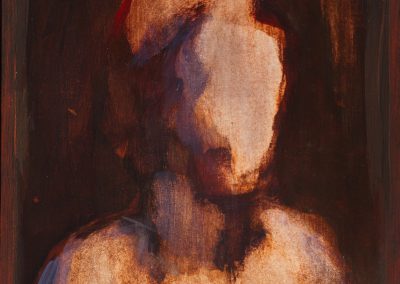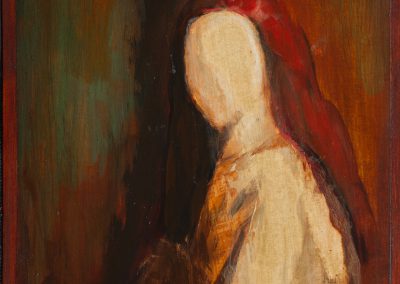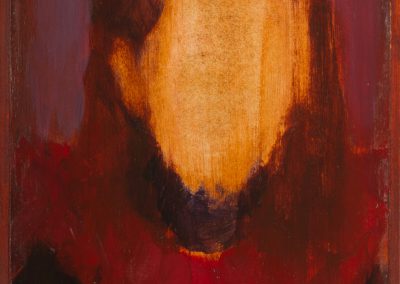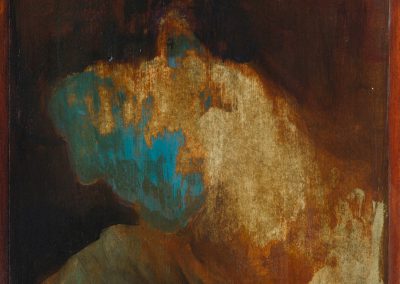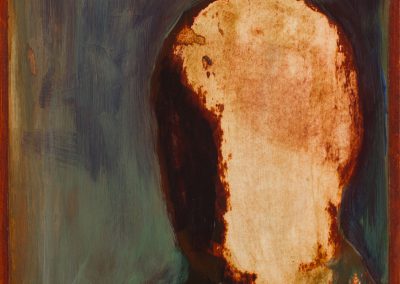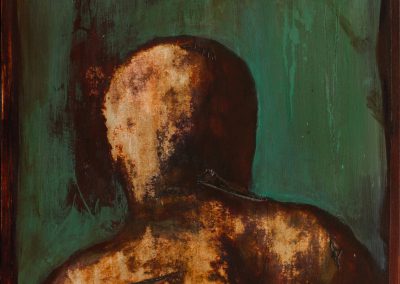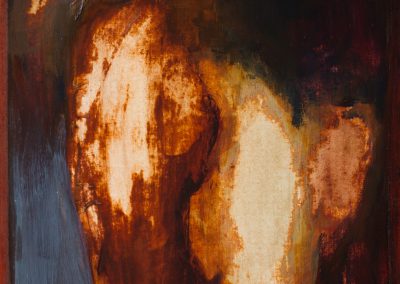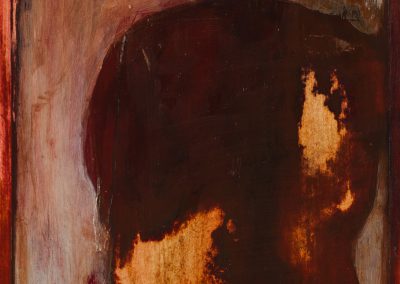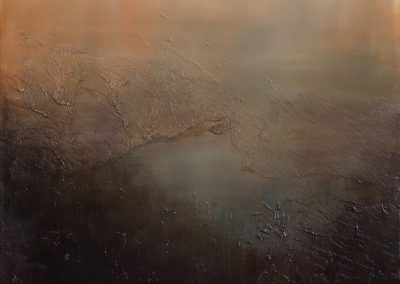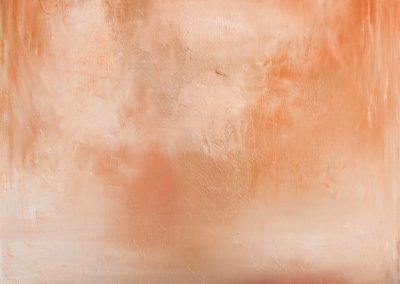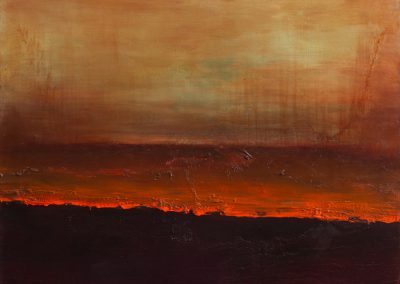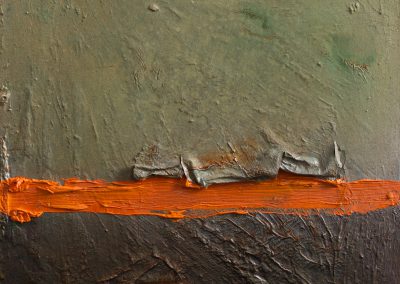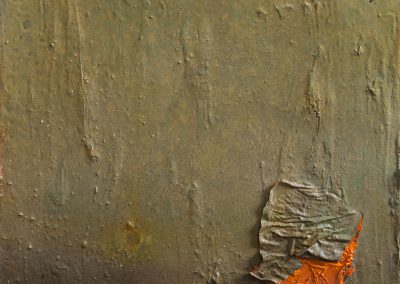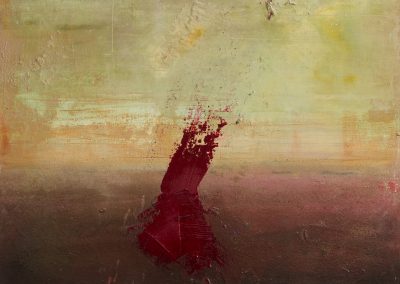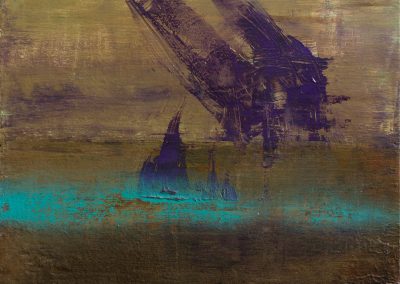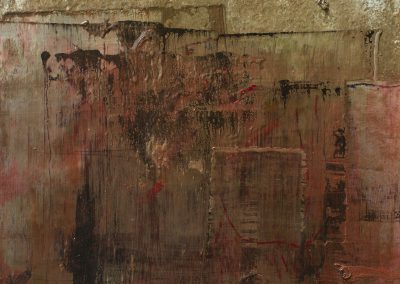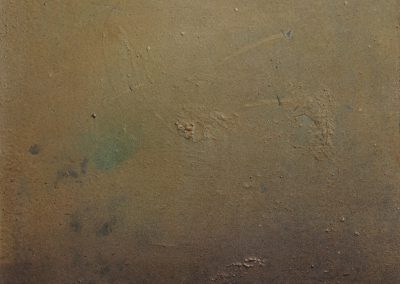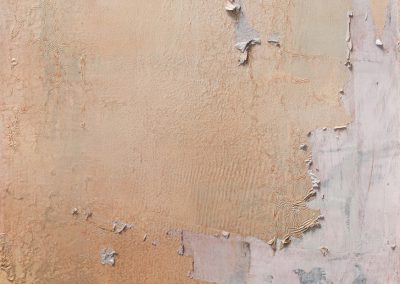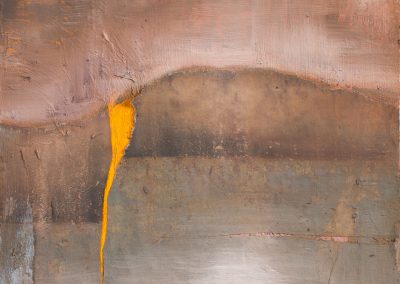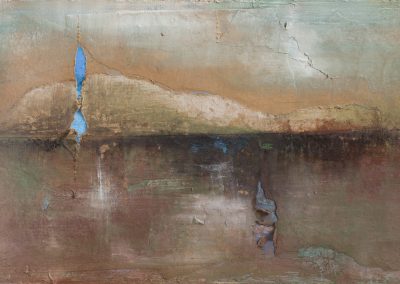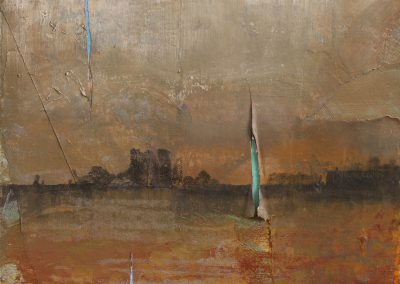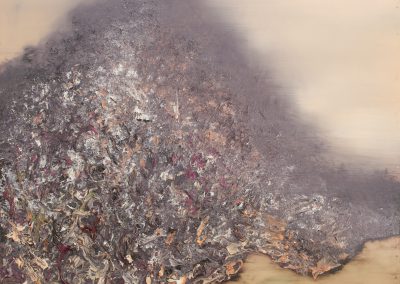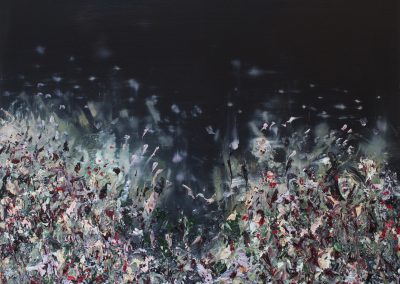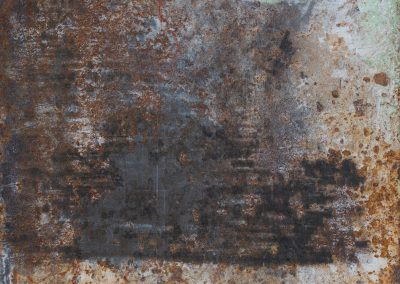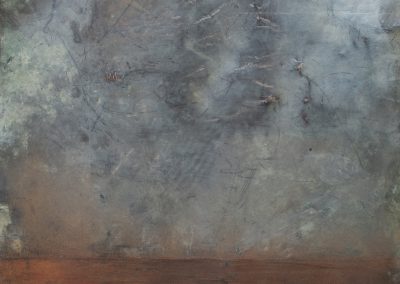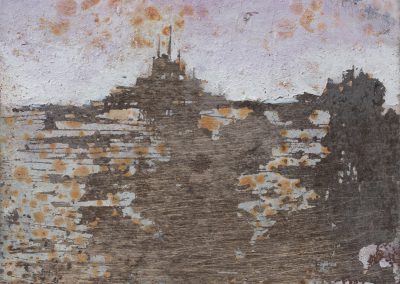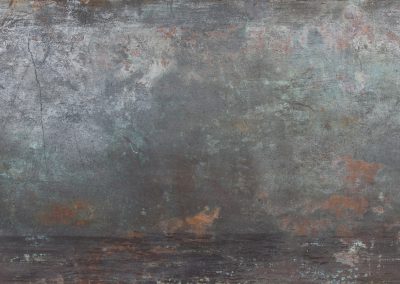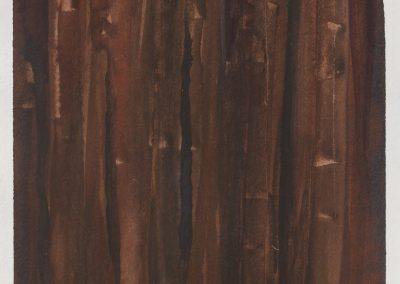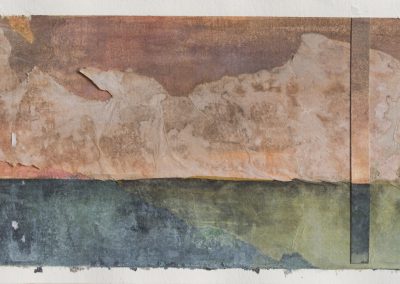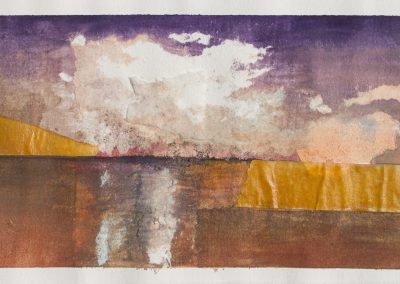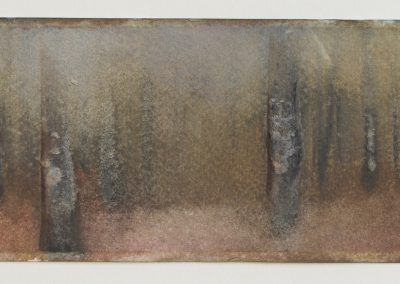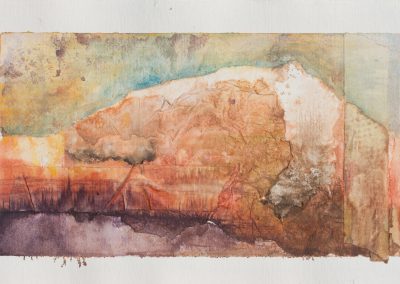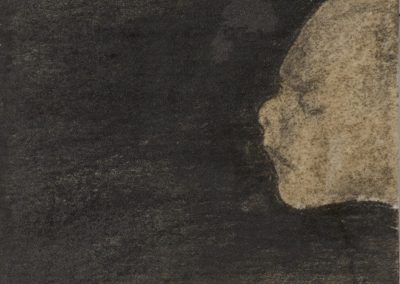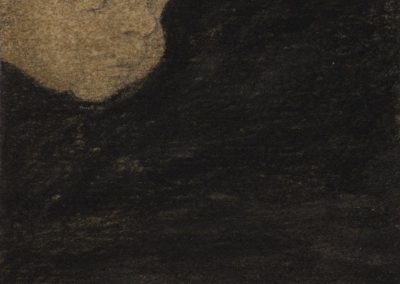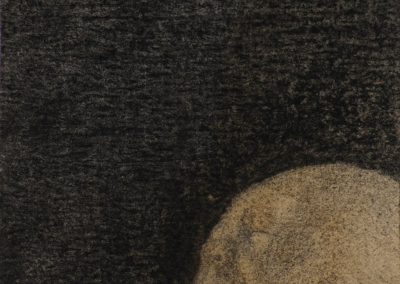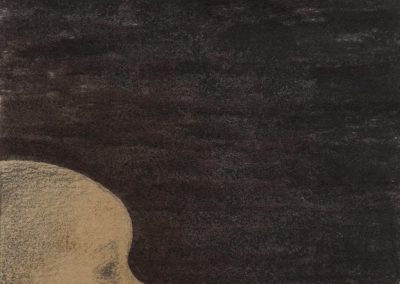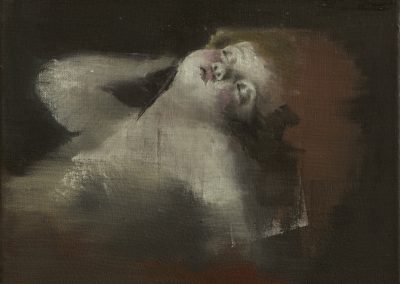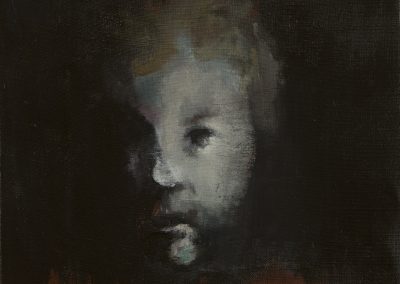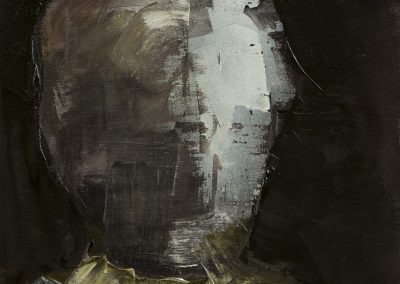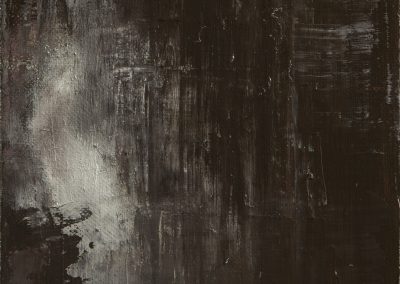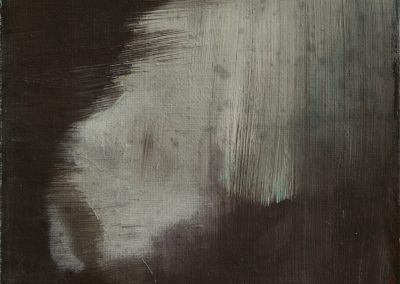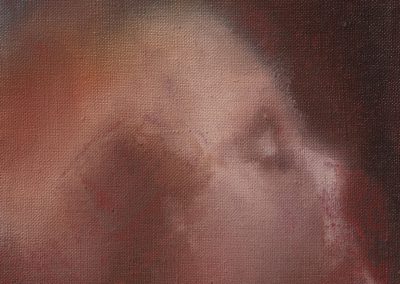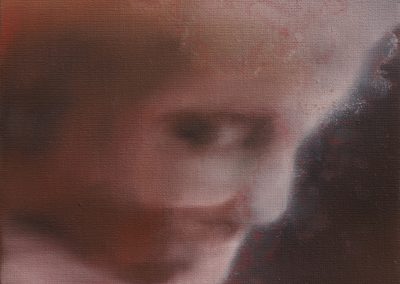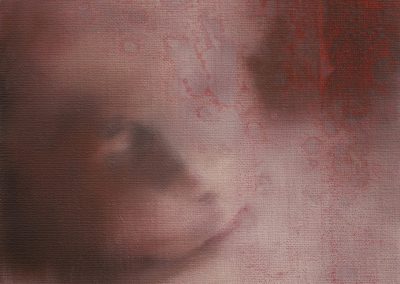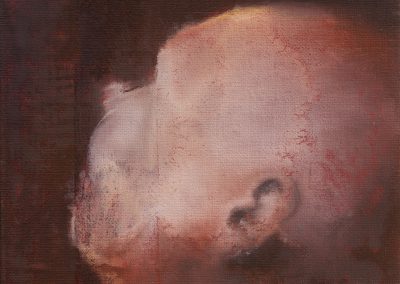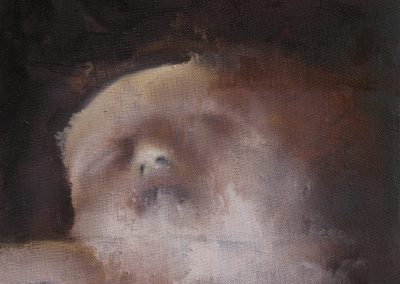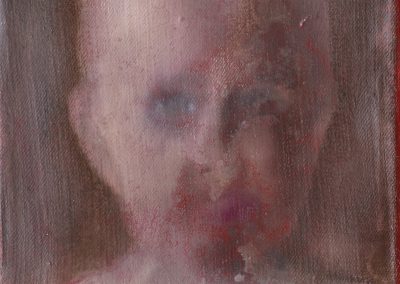For sale. Brand new willies. Overused. | Welcome home, saudade
Az elbeszélés olyan gondolkodási minta, ami a történéseket, az embert érő hatásokat értelemmel ruházza fel. Ok-okozati kapcsolatra épülve, időben rendszerezve beszéli el a valóságról vagy a vélt, kitalált környezetről szóló tapasztalatokat, érthetővé téve a láthatót. Figuratív és egyben absztrakt képi elbeszéléseimen a narratíva már csak érzékelhető, hiszen egyfajta kiretusálásként a munkák a történet legfontosabb pillanatainak elfedése, meg nem jelenítése által kiváltott bizonytalanságon alapulnak. Ismerős, vagy annak vélt figurák és motívumok találkoznak egy adott környezetben, kialakítva egy határozottan érezhető, ugyanakkor nehezen megfejthető interakciót. Látszólag nincs ok-okozati összefüggés, nem bizonyosságban él a kép. Nem alkot letapogatható láncolatot, ahol dekódolható a térben és az időben értelmezhető elbeszélés. Az absztrahálás, az érzékelhető valóságtól való elvonatkoztatás mellett történik egy transzponálás, dimenzióváltás. Történetem főszereplője az örökké visszatérő rossz társaság, érzésemlékekből fakadó vadonatúj, mégis agyonhasznált félelem. Így halvány sejtés szintjén körvonalazódik a rejtett narratíva, mely a felfejtésre váró jelentésrétegeivel teszi érzékelhetővé a láthatatlant.
Képeim motívumait az elmúlt években redukáltam, a vadonatúj és egyben agyonhasznált félelem szimbólumot helyeztem a fókuszba. Egy entitás, amolyan rém-lik, amely egyszer egy örvényként, majd annak inverzeként a lebegő folt formáját ölti magára. A képek emberi (mellék)szereplői ehhez a duális jelhez inkább csak statisztálnak, olykor tudomást sem vesznek róla vagy magukévá teszik. Figuráimat és karaktereimet lecsupaszítottam, mivel a kisbetűs embert akarom ábrázolni, aki még tömegben is magányos. Magányával pedig egy tömeget alkot, mely semleges és üres térben vagy épp színpadias, nem evilági tájképekben keresgél.
Narration is a thinking pattern which bestows meaning upon events and forces impacting humans. It describes experience of real or imagined environments based on causality and chronology; it renders the visible understandable. In my figurative and at the same time abstract visual narratives the story telling is only just perceivable, as the basis of my pieces is the uncertainty caused by hiding the most important moments of the story, much like in a blurred image. Figures and motifs that we are familiar with or we believe to be familiar meet in a given environment creating a well detectable, nevertheless not easily decodable interaction. There is seemingly no cause and effect, and the picture remains outside of certainty. It does not form a surveyable chain of events where a narrative which is to be interpreted in space and time can be decoded. Also, conversion and changing of dimensions take place beside abstraction and not representing the perceivable reality. The protagonist of my narrative is the ever returning bad company: the brand new, yet battered fear originating from memories of feelings. Thus, at the level of vague suspicion a hidden narrative takes shape, which renders the invisible perceivable with its layers of meaning waiting to be unpacked.
In past years, I reduced the motives of my pictures and put the symbol of brand new and at the same time worn-out anxiety in focus: an entity similar to a hole which simultaneously takes on the form of a whirlpool and its inverse as a floating blob. The human (side) characters of the pictures are only extras in this duality: sometimes they do not even take notice of it, sometimes they own it. I have bared my figures and characters, for I want to depict the common people – with a lowercase p – who are lonesome even in a crowd. With their loneliness they create a crowd searching in a neutral or, on the contrary, theatrical landscape not from this world.
Welcome back, saudade
A portugál ’saudade’ kifejezés nem csupán az általunk ismert honvágy jelentését hordozza. Magában foglal egyfajta nosztalgikus, ugyanakkor fájdalmas, sóvárgó vágyat, egy számunkra már nem létező élethelyzet, valaki vagy valami iránt, legyen szó akár tér vagy időbeli távolságról. Ugyanakkor fiktív, nem létezőhöz kapcsolódó hiányérzet esetén is aktuális a kifejezés. Olyan szimbólumokkal foglalkozom, amikre jellemző a dualitás. Az ágy is egy ilyen kettős jelkép. Egyrészt utal az életre és a születésre, másrészt pedig a halált és az elmúlást is magában hordozza. Ez a dualitás jelenik meg a képeken, a két állapot közötti, egyfajta éteri lebegés. Itt az ágy már nem csak egy tárgy és szimbólum, sokkal inkább egy entitás, önálló személy.
The Portuguese term saudade does not simply mean homesickness. It also includes a feeling of nostalgia, a painful longing for a situation which ceased to exist for us, a yearning for someone or something removed in time or in space. However, the term is also adequate in the case of void caused by something nonexistent or fictitious. I explore symbols that are characterized by duality. The bed is such a symbol. On the one hand it refers to life and birth, on the other hand it also bears the meaning of death and passing. This duality can be found in the pictures: an ethereal floating between two states. The bed here is not only an object and a symbol; it is rather an entity, an independent persona.
Welcome back, saudade
Breaking news / Skip ad
Breaking news / Skip ad
Hiányból vákuumba / From absence into vacuum
A megfoghatatlan érzetek kifejtéséhez indokolttá válik egy saját kibogozhatatlan történet teremtése, ahol a széthullott jelenetekben egyszerre érezhető a horror misztikuma és egy víziókhoz hasonlatos világ megfogalmazása. A narratíva megtestesíti az amorf szorongást egy hozzá társítható dimenzión keresztül, torz teremtményekkel bemutatva, ahol nem a brutalitás, az agresszió eseménye, akciója jelenik meg, hanem az azt megelőző vagy az azt követő feszült pillanat kimerevítése kerül középpontba.
A történetiség érzetét nem mellőző metaforikus munkák a narratíva legfontosabb pillanatainak elfedése, meg nem jelenítése által kiváltott bizonytalanságon alapulnak. Az így megidézett morbid mesevilág színpadias, vízió- és álomszerű kivetülése nem tartalmaz tökéletesen felismerhető és kategorizálható karaktereket. Titokban hagyom az interakciót a szintén kérdéses áldozat és elkövető szerepe között. Nem állítom, hogy valami gyomorforgató brutalitás utáni pillanat látható a képeken, de megvan a lehetősége, mint ahogy annak is, hogy épp valami banálisan röhejes, groteszk jelenet következik.
To express intangible feelings, it becomes reasonable to create my own inextricable story which derives from me. In its fragmented scenes, one can perceive the mystique of horror and the drafting of a vision-like word at the same time. The narrative embodies the amorf anxiety through a dimension associated with it, demonstrated by misshapen creatures. Here, not the action of brutality, the event of aggression is shown, but the focus is on the tense moment immediately before or after it, frozen in time.
The metaphorical pieces, which do feel like stories, are based on the sense of insecurity caused by the obscuration of the most important moments of the narrative. This theatrical vision-like and dreamlike manifestation of the evoked morbid fairy tale world does not contain any perfectly recognisable characters that can easily be categorised.
I leave open the interaction between the also questionable roles of the victim and the perpetrator, of the expelled and the rejecter. I do not claim that the pieces depict the moment after some gory brutality, but the possibility is there. Just like the possibility that what follows is a trivial, ridiculous, and grotesque scene.
Hiányból vákuumba / From absence into vacuum
Blaszfémia / Blasphemy
A természet, az anyag nem önmagában rossz, csak a létbeli fogyatékossága miatt rosszként jelentkezhet, úgy létbe vetettségünk során egyszerre állhat fenn a blaszfémia helye, ideje, és helytelensége, időtlensége.
Nature and matter are not evil by themselves, they can only manifest as evil due to their deficiency in their being. Similarly, throughout our having been thrown into existence, blasphemy can have its place and time, and simultaneously be placeless and timeless.
Blaszfémia / Blasphemy
Ismeretlen szerző / Unknown author | Sóvárgók / The ones who yearns
Ismeretlen szerző
Az Ismeretlen szerző című ciklus homályban veszteglő portréi a bűnbeesettség állapotát tükrözik. Az oldhatatlan sóvárgást az ismeretlen szerző iránt, a predesztináció fogalmának dualitásával mutatják a képek.
Sóvárgók
legyen
a láthatatlan érzékelhető
hogy a tettre kész
cselekvőképtelen
legyen
Merre indulhat az ember, ha a benne lévő felemésztő és egyben tápláló, megfoghatatlan, de mégis érzékelhető talajt akarja feltárni? Az ismeretlen szerző iránti oldhatatlan sóvárgás késztet minket az ásásra vagy a horror vacui elavult elve ölt magára új szerepet? A kézzelfogható üresség érzete egy tapodtat sem mozdul mellőlünk és nem győzzük kántálni: Sötétség nem létezik, csak a fény hiánya. Itt vagyunk a hiány pillanatában, maradunk lecsupaszítva a senki földjén, Teremtmény és Teremtő között megrekedve,
Nem ácsingózó
Nem áhítozó
Nem vágyakozó
Sóvárgó
Unknown Author
The “Unknown Author” cycle’s portraits lie in obscurity reflecting the state of men’s falling into sin. The pictures show the unquenchable longing for the unknown author in duality with the notion of predestination.
The ones who yearns
let
the invisible be perceptible
so that the eager
is
incapacitated
Where can one go if they want to uncover the devouring and yet nourishing, intangible but still perceivable ground in themselves? Does the unquenching yearning for the unknown author prompt us to dig or is it a new role taken up by the outdated principle of horror vacui? A sense of tangible void will not leave us and we keep on chanting: There is no darkness, just the lack of light. We are here in the moment of absence, and we stay naked in no man’s land, stranded between Creature and Creator.
Not hankering
Not longing
Not craving
Yearning
Ismeretlen szerző / Unknown author | Sóvárgók / The ones who yearns
Ott vagyunk már? / Are we there yet?
Ott vagyunk már?
Megjelenik a dualitás az abszurditás édes bizonytalanságában.
Tájkép vagy közel sem az.
Emlék vagy épp jövőkép.
Kapaszkodó és egy szálka a kapaszkodó kézbe.
Üresség vagy épp lehetőség van a sötétségben?
Az Ott vagyunk már? című sorozat belső tájképei rétegekből felépített munkák. Egyfajta bizonytalanság keltése, játék a horizonttal vagy épp annak hiányával, megbolygatva a tereket és kiélezve a már amúgy is vékony határt a megrázó, drámai, idegesítő és furcsa érzetek között. A címmel együtt alkotott világ illusztrációi ezek a munkák, felidézvén a már gyermekkorban gyakran feltett kérdést. Mikor nem is tudtuk merre tartunk, türelmetlenül próbáltuk elképzelni a végpontot és ennek a célnak a kivetített képe, mint egy felsérthető, ingatag fátyol, lebegett és lebeg a mai napig.
Ott vagyunk már? A kérdésre lehet kérdéssel válaszolni, hol van az „ott”, mikor semmi konkrétat nem látunk, és egyáltalán kikre vonatkozik a „vagyunk”? Asszociálhatunk egy megtett, vagy épp előttünk lévő útra, melynek során folyamatosan találkozunk tényleges vagy vélt problémákkal. Valamikor tisztán látjuk a célt, máskor pedig azt sem tudjuk miért torpantunk meg. A felmerülő kérdés pedig néha zavarba ejtően értelmezhetetlen, vagy talán nincs is rá válasz. A néző kap kapaszkodót, segítséget, de ugyanannyi problémát is, holott a feloldhatatlan bizonytalanságból csak az ellentmondást nem tűrő biztonságba lépünk be szívesen. Ez azonban mind a képeken, mind a valóságban ritkán tapasztalható. Kapaszkodó és egy szálka a kapaszkodó kézbe.
Are we there yet?
Duality appears in the sweet insecurity of absurdity.
A landscape or not at all.
A memory or a vision of the future.
A handhold and a splinter in the grasping hand.
Is there a void or a possibility in darkness?
The inner landscapes of the cycle Are We There Yet? are works built from layers. They are causing insecurity, playing with the horizon or its absence, disturbing spaces and sharpening the already thin borderline between feelings of shock, drama, annoyance, and weirdness. These works are illustrations of a world created with the title, evoking the question, which is often asked even in childhood. When we did not even know where we were headed, and impatiently tried to imagine the endpoint. And the projected image of this goal was and to this day still is hovering above us as a vulnerable and unsteady veil.
Are we there yet? This question can be answered with another question: Where is there, when we cannot see anything concrete? And who does we even refer to? We can think of a journey already finished or yet to be taken, during which we constantly face real or imagined problems. At times we see the goal clearly, other times we do not even know why we stopped. The emerging question is on the other hand sometimes disturbingly incomprehensible; it might not have an answer at all. The viewer gets some points of reference, some help, but they get just as many problems, although we would only like to enter the realm of security without contradictions coming from a place of irreconcilable insecurity. This, however, can only rarely be experienced both in the pictures and in reality. A handhold and a splinter in the grasping hand.
Ott vagyunk már? / Are we there yet?
Aprószentek / Holy Innocents
Aprószentek / Holy Innocents

